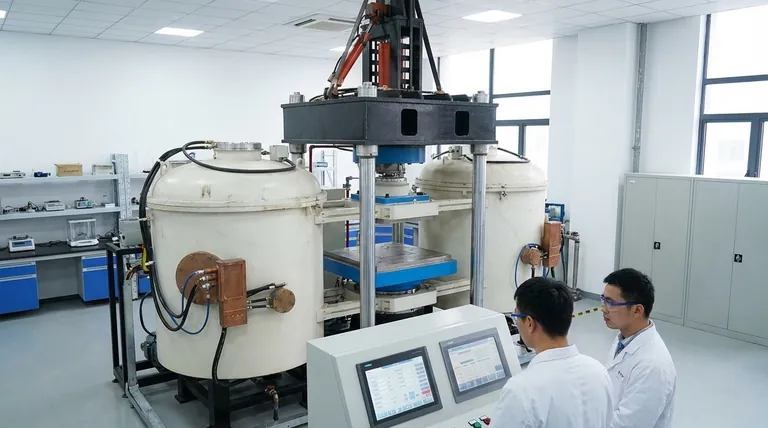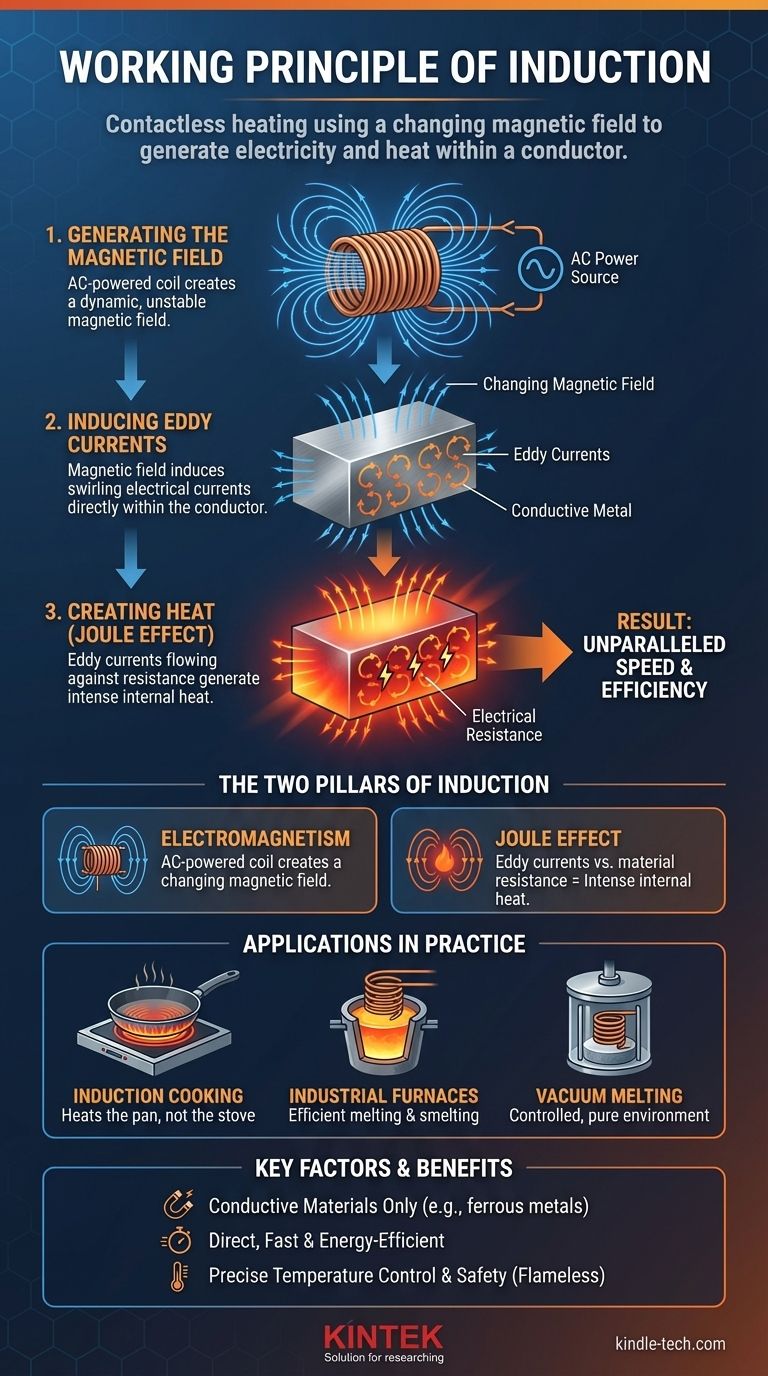The working principle of induction is the use of a changing magnetic field to generate electricity within a conductor, which in turn creates heat. An alternating current (AC) is passed through a coil, producing a dynamic magnetic field. When a conductive material, like an iron pan or metal in a furnace, is placed within this field, the field induces swirling electrical currents—known as eddy currents—directly within the material, heating it from the inside out.
Induction is fundamentally a method of contactless heating. Instead of using a flame or a hot surface, it turns the target object into its own heat source by leveraging the principles of electromagnetism and electrical resistance, resulting in unparalleled speed and efficiency.

The Two Pillars of Induction: Electromagnetism and Resistance
To grasp how induction works, we need to look at two fundamental physical principles working in sequence. The entire process transforms electrical energy into magnetic energy, and finally into thermal energy.
Step 1: Generating the Magnetic Field
The process begins with an induction coil, typically made of copper.
An alternating current (AC) is sent through this coil. Because the current is constantly and rapidly changing direction, it generates a dynamic and unstable magnetic field around the coil.
Step 2: Inducing Eddy Currents
This fluctuating magnetic field expands and collapses, passing through any conductive material placed nearby.
According to Maxwell's equations of electromagnetism, this changing magnetic field induces small, circular electrical currents within the conductor. These are called eddy currents.
You can visualize these currents as tiny whirlpools of electricity swirling inside the material.
Step 3: Creating Heat Through the Joule Effect
Every conductor has some natural electrical resistance. As the induced eddy currents flow through the material, they encounter this resistance.
This friction between the flowing electrons and the material generates intense heat. This phenomenon is known as the Joule Effect, and it is the final step that converts electrical energy into useful thermal energy.
How Induction is Applied in Practice
The same core principle applies across a vast range of applications, from home kitchens to heavy industry, with the main difference being the scale and power involved.
Induction Cooking: Heating the Pan, Not the Stove
In an induction cooktop, the coil is located beneath the ceramic glass surface. When you place an iron-based (ferrous) pot on top, the magnetic field induces eddy currents directly into the base of the pot.
The pot itself becomes the source of heat, which is then transferred to the food inside via conduction. The cooktop surface remains cool because the magnetic field does not affect it.
Industrial Furnaces: The Transformer Analogy
A core-type induction furnace operates exactly like a power transformer.
A primary coil surrounds an iron core. The "secondary coil" is a closed loop formed by the molten metal itself. The immense current induced in this metal loop generates the heat required for melting and smelting, achieving power efficiencies of up to 98%.
Vacuum Melting: Induction in a Controlled Environment
For metals that react with oxygen or nitrogen, the entire induction process can be placed inside a vacuum chamber.
This allows for the melting of highly reactive alloys without contamination. The principle remains identical: a coil induces eddy currents in the metal charge, heating and melting it in a pure, airless environment.
Understanding the Trade-offs
Induction heating is powerful, but its effectiveness is dictated by a clear set of physical constraints and benefits.
The Critical Role of Material
The single greatest factor is material dependency. The target object must be electrically conductive to allow eddy currents to form.
For cooking, this is why pans must have a ferrous (iron or steel) base. Materials like copper and aluminum are conductive, but their magnetic properties make them less suitable for standard cooktops. Glass, ceramic, and stone will not heat at all.
Unmatched Efficiency and Speed
The primary advantage of induction is its direct heating method. Energy is generated inside the workpiece, not transferred to it from an external source.
This minimizes heat loss to the surrounding environment, making the process incredibly fast and energy-efficient compared to conventional heating.
Precision and Safety
Heating is instantaneous. It begins the moment the magnetic field is generated and stops the moment it is turned off.
This provides exceptionally precise temperature control. In applications like cooking, the lack of an open flame or a hot surface (other than the pan itself) makes it a significantly safer method.
Making the Right Choice for Your Goal
Understanding the core mechanism allows you to determine when induction is the optimal solution.
- If your primary focus is speed and energy efficiency: Induction is a leading choice because it transfers energy directly into the material without contact or waste.
- If you are working with non-conductive materials like ceramic or glass: Induction will not work, and you must rely on traditional heating methods like conduction, convection, or radiation.
- If your primary focus is precision and safety: The instantaneous and flameless nature of induction provides superior control and a safer operating environment.
By turning a material into its own heater, induction offers a clever and powerful application of physics to heat things cleanly, quickly, and with remarkable efficiency.
Summary Table:
| Principle | Key Component | Result |
|---|---|---|
| Electromagnetism | AC-powered coil creates a changing magnetic field. | Induces swirling electrical currents (eddy currents) in a conductor. |
| Joule Effect | Eddy currents flow against the material's electrical resistance. | Generates intense, internal heat directly within the material. |
Need precise, efficient, and safe heating for your laboratory processes?
KINTEK specializes in high-performance lab equipment, including induction heating systems designed for accuracy and reliability. Whether you are melting metals, conducting heat treatment, or require controlled thermal processing, our solutions deliver unmatched speed and energy efficiency.
Contact us today to discuss how our induction technology can enhance your laboratory's capabilities and productivity. Get in touch via our contact form to speak with an expert!
Visual Guide

Related Products
- 600T Vacuum Induction Hot Press Furnace for Heat Treat and Sintering
- Platinum Sheet Electrode for Laboratory and Industrial Applications
- Silicon Carbide SiC Thermal Heating Elements for Electric Furnace
- Lab-Scale Vacuum Induction Melting Furnace
- High Pressure Laboratory Vacuum Tube Furnace Quartz Tubular Furnace
People Also Ask
- What are the disadvantages of hot pressing? Key Limitations for Your Manufacturing Process
- What is vacuum hot pressing? Achieve Maximum Density & Purity in Advanced Materials
- What products are made by hot pressing? Achieve Maximum Density and Performance for Your Components
- Can you get an electrical arc in vacuum? How High Voltage Creates Plasma in a Void
- What does bond strength depend on in braze welding? Master the 3 Keys to a Strong Joint



















